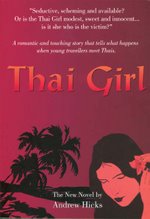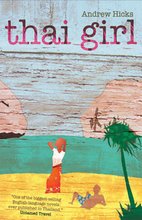




The rice has been cut and is lying in the fields in small stooks or bundles where it will be left for a few days to dry. The next stage is threshing. While in the Thai language threshing is ‘nuat khao’, ‘nuat Thai’ is Thai massage. They’re massaging the rice!
Threshing used to be done by hand, a laborious process in which the stooks were beaten on the ground to dislodge the grains which were then tossed on woven trays and fanned to winnow away the scraps of chaff and grass. Now it’s all done by machine and the work of days is done in a few hours.
The thresher is booked and arrives in the field where everyone is waiting in a fever of excitement. This is the climax of the year when the bags of rice will be anxiously counted and they’ll know for sure what sort of a crop they’ve got.
It’s a substantial machine mounted on an old truck and is always painted pale blue. It arrives under its own steam and the vehicle’s prop shaft is dropped down so that the diesel engine can supply power to the thresher. A complex series of rubber belts taken off the shaft then drives the machinery that shakes the grains off the stalks. These dribble into a brown hessian sack, while the straw is ejected in a steady stream high into the air. This forms a hay stack that will be used as animal feed over the coming dry season.
Threshing needs a big gang of labour as many loads of stooks have been brought together and these have to be tossed into the hungry machine for the job to be done as quickly and efficiently as possible. The hire is paid by the hour and the machine is booked for another job as soon as this one is finished.
It’s a hot and messy job and everyone’s swathed in balaclavas, long shirts and trousers, plus hat and rubber boots. They stand on the stack taking it in turns to throw the stooks into the chute, the dust and chaff flying, the machinery roaring and grinding and spitting fumes.
It’s hard work but nobody objects as this is a universal festival, celebrating fertility and the season’s cycle of labour. It’s sociable and fun and there’s alcohol and food to be had. The women do their share of the heavy work but they’ve also brought with them big aluminium pots full of dark curries and of course large quantities of cooked white rice.
It’s a great atmosphere out there in the fields, all dry and brown with only the rice stubble now in the fields. There’s bright colour and laughter and children and dogs and a grandmother or two always there to lend a hand and to take part in this great harvest home. Just as real life should be.
It must have been like this half an age ago in the West when agriculture was still labour intensive and large numbers worked on the land. Now at harvest festival in English village churches there are tins of peas and produce bought in the supermarket stacked high by the altar and it isn’t quite the same any more.
So I now feel lucky to be so closely a part of all that goes on in our village in the rice fields of Thailand today. It’s a world I never thought in my wildest dreams I’d be a part of.





5 comments:
Thanks so much for the pics. I have been wondering about this for quite a while, and was still imagining this work being done by hand. Pray tell, what is the baseball bat next to the beer bottle for? Keeping the local farang in line?
I suspect you are looking at a large motar and pestal combo, but not sure, if you examine the picture.
The "baseball bat" is the pestle for the mortar next to it. And the "beer" bottle is not beer, but a bottle of the "infamous" lao kao, About 40% alcohol. Will peel paint and guarranteed to give you a nice hangover. My wife reffers to it simply as "40 degree".
Canæt have any form of work done up here without offering the workers some. he he
Thank You for this nice blog, You bringing life there a bit closer.
My wife is allso from a Suai village not very far from Sankha, and we're going to stay in Surin for 4 weeks in January.
Yes, it's a pok pok for pounding chillies and all sorts of other foods into a paste to eat with rice. This, the rice farmer's hat and the bottle are all social icons round here!
And Drowsy, do contact me at arhicks56@hotmail.com if you're coming our way. I'm away in the middle of January but it'd be good to be in touch.
Andrew
Post a Comment